Yunqi Miao
Unlocking the Potential of Diffusion Priors in Blind Face Restoration
Aug 12, 2025
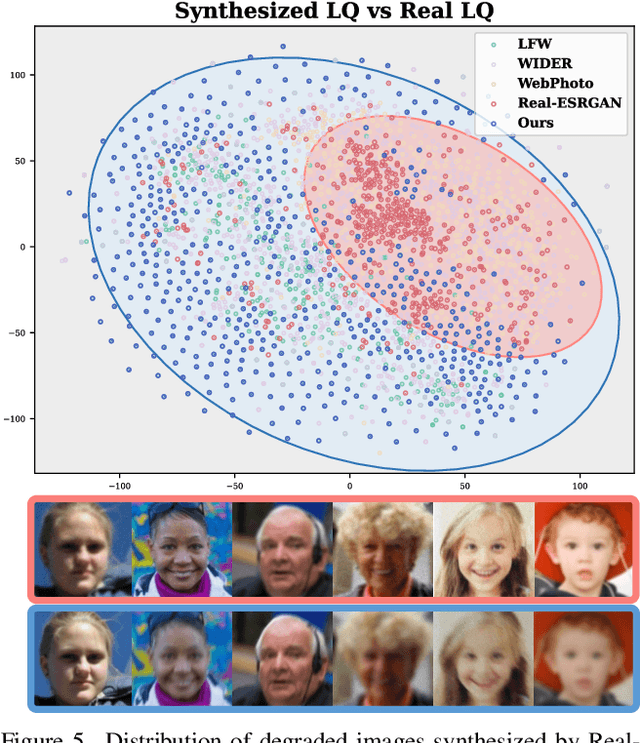
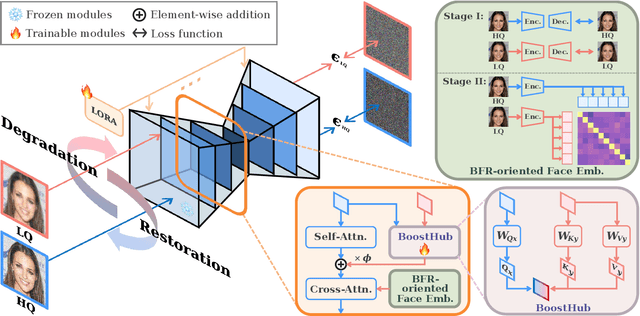
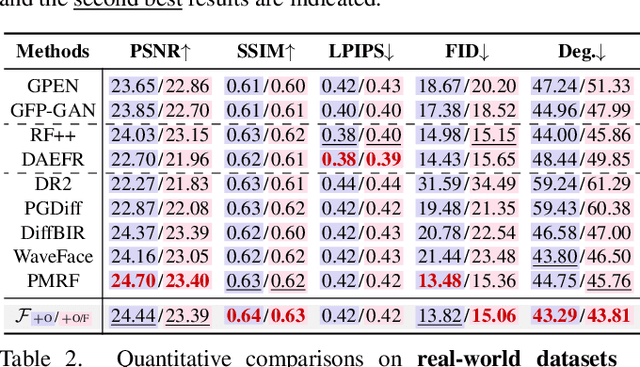
Abstract:Although diffusion prior is rising as a powerful solution for blind face restoration (BFR), the inherent gap between the vanilla diffusion model and BFR settings hinders its seamless adaptation. The gap mainly stems from the discrepancy between 1) high-quality (HQ) and low-quality (LQ) images and 2) synthesized and real-world images. The vanilla diffusion model is trained on images with no or less degradations, whereas BFR handles moderately to severely degraded images. Additionally, LQ images used for training are synthesized by a naive degradation model with limited degradation patterns, which fails to simulate complex and unknown degradations in real-world scenarios. In this work, we use a unified network FLIPNET that switches between two modes to resolve specific gaps. In Restoration mode, the model gradually integrates BFR-oriented features and face embeddings from LQ images to achieve authentic and faithful face restoration. In Degradation mode, the model synthesizes real-world like degraded images based on the knowledge learned from real-world degradation datasets. Extensive evaluations on benchmark datasets show that our model 1) outperforms previous diffusion prior based BFR methods in terms of authenticity and fidelity, and 2) outperforms the naive degradation model in modeling the real-world degradations.
WaveFace: Authentic Face Restoration with Efficient Frequency Recovery
Mar 19, 2024
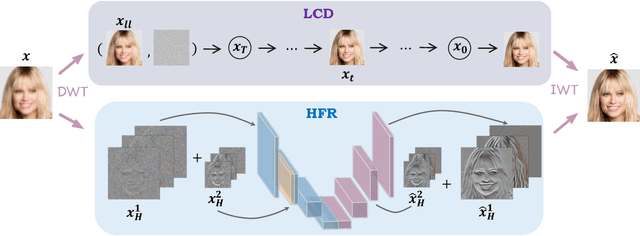


Abstract:Although diffusion models are rising as a powerful solution for blind face restoration, they are criticized for two problems: 1) slow training and inference speed, and 2) failure in preserving identity and recovering fine-grained facial details. In this work, we propose WaveFace to solve the problems in the frequency domain, where low- and high-frequency components decomposed by wavelet transformation are considered individually to maximize authenticity as well as efficiency. The diffusion model is applied to recover the low-frequency component only, which presents general information of the original image but 1/16 in size. To preserve the original identity, the generation is conditioned on the low-frequency component of low-quality images at each denoising step. Meanwhile, high-frequency components at multiple decomposition levels are handled by a unified network, which recovers complex facial details in a single step. Evaluations on four benchmark datasets show that: 1) WaveFace outperforms state-of-the-art methods in authenticity, especially in terms of identity preservation, and 2) authentic images are restored with the efficiency 10x faster than existing diffusion model-based BFR methods.
Confidence-guided Centroids for Unsupervised Person Re-Identification
Nov 22, 2022



Abstract:Unsupervised person re-identification (ReID) aims to train a feature extractor for identity retrieval without exploiting identity labels. Due to the blind trust in imperfect clustering results, the learning is inevitably misled by unreliable pseudo labels. Albeit the pseudo label refinement has been investigated by previous works, they generally leverage auxiliary information such as camera IDs and body part predictions. This work explores the internal characteristics of clusters to refine pseudo labels. To this end, Confidence-Guided Centroids (CGC) are proposed to provide reliable cluster-wise prototypes for feature learning. Since samples with high confidence are exclusively involved in the formation of centroids, the identity information of low-confidence samples, i.e., boundary samples, are NOT likely to contribute to the corresponding centroid. Given the new centroids, current learning scheme, where samples are enforced to learn from their assigned centroids solely, is unwise. To remedy the situation, we propose to use Confidence-Guided pseudo Label (CGL), which enables samples to approach not only the originally assigned centroid but other centroids that are potentially embedded with their identity information. Empowered by confidence-guided centroids and labels, our method yields comparable performance with, or even outperforms, state-of-the-art pseudo label refinement works that largely leverage auxiliary information.
Physically-Based Face Rendering for NIR-VIS Face Recognition
Nov 11, 2022Abstract:Near infrared (NIR) to Visible (VIS) face matching is challenging due to the significant domain gaps as well as a lack of sufficient data for cross-modality model training. To overcome this problem, we propose a novel method for paired NIR-VIS facial image generation. Specifically, we reconstruct 3D face shape and reflectance from a large 2D facial dataset and introduce a novel method of transforming the VIS reflectance to NIR reflectance. We then use a physically-based renderer to generate a vast, high-resolution and photorealistic dataset consisting of various poses and identities in the NIR and VIS spectra. Moreover, to facilitate the identity feature learning, we propose an IDentity-based Maximum Mean Discrepancy (ID-MMD) loss, which not only reduces the modality gap between NIR and VIS images at the domain level but encourages the network to focus on the identity features instead of facial details, such as poses and accessories. Extensive experiments conducted on four challenging NIR-VIS face recognition benchmarks demonstrate that the proposed method can achieve comparable performance with the state-of-the-art (SOTA) methods without requiring any existing NIR-VIS face recognition datasets. With slightly fine-tuning on the target NIR-VIS face recognition datasets, our method can significantly surpass the SOTA performance. Code and pretrained models are released under the insightface (https://github.com/deepinsight/insightface/tree/master/recognition).
On Exploring Pose Estimation as an Auxiliary Learning Task for Visible-Infrared Person Re-identification
Jan 11, 2022
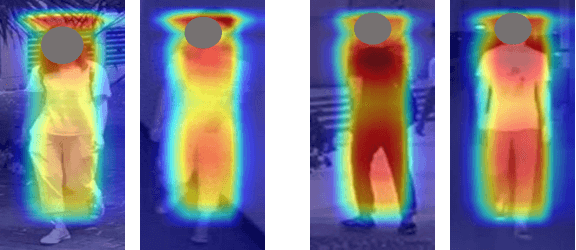
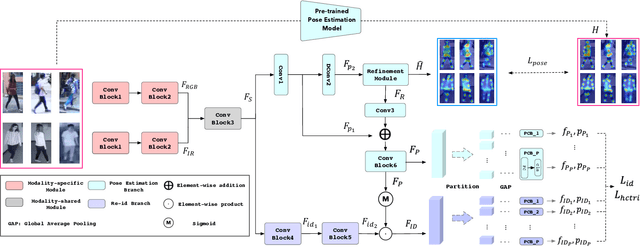
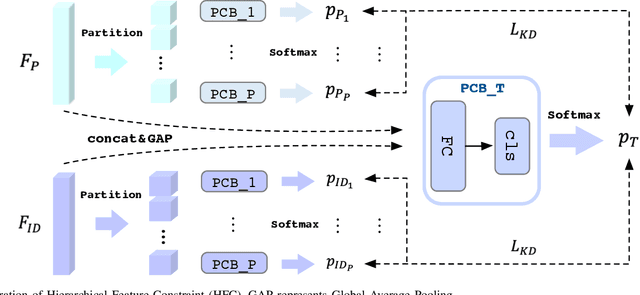
Abstract:Visible-infrared person re-identification (VI-ReID) has been challenging due to the existence of large discrepancies between visible and infrared modalities. Most pioneering approaches reduce intra-class variations and inter-modality discrepancies by learning modality-shared and ID-related features. However, an explicit modality-shared cue, i.e., body keypoints, has not been fully exploited in VI-ReID. Additionally, existing feature learning paradigms imposed constraints on either global features or partitioned feature stripes, which neglect the prediction consistency of global and part features. To address the above problems, we exploit Pose Estimation as an auxiliary learning task to assist the VI-ReID task in an end-to-end framework. By jointly training these two tasks in a mutually beneficial manner, our model learns higher quality modality-shared and ID-related features. On top of it, the learnings of global features and local features are seamlessly synchronized by Hierarchical Feature Constraint (HFC), where the former supervises the latter using the knowledge distillation strategy. Experimental results on two benchmark VI-ReID datasets show that the proposed method consistently improves state-of-the-art methods by significant margins. Specifically, our method achieves nearly 20$\%$ mAP improvements against the state-of-the-art method on the RegDB dataset. Our intriguing findings highlight the usage of auxiliary task learning in VI-ReID.
Shallow Feature Based Dense Attention Network for Crowd Counting
Jun 17, 2020
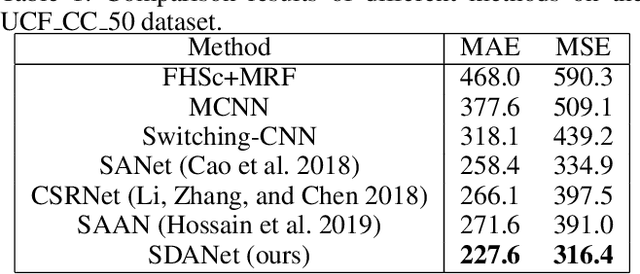


Abstract:While the performance of crowd counting via deep learning has been improved dramatically in the recent years, it remains an ingrained problem due to cluttered backgrounds and varying scales of people within an image. In this paper, we propose a Shallow feature based Dense Attention Network (SDANet) for crowd counting from still images, which diminishes the impact of backgrounds via involving a shallow feature based attention model, and meanwhile, captures multi-scale information via densely connecting hierarchical image features. Specifically, inspired by the observation that backgrounds and human crowds generally have noticeably different responses in shallow features, we decide to build our attention model upon shallow-feature maps, which results in accurate background-pixel detection. Moreover, considering that the most representative features of people across different scales can appear in different layers of a feature extraction network, to better keep them all, we propose to densely connect hierarchical image features of different layers and subsequently encode them for estimating crowd density. Experimental results on three benchmark datasets clearly demonstrate the superiority of SDANet when dealing with different scenarios. Particularly, on the challenging UCF CC 50 dataset, our method outperforms other existing methods by a large margin, as is evident from a remarkable 11.9% Mean Absolute Error (MAE) drop of our SDANet.
 Add to Chrome
Add to Chrome Add to Firefox
Add to Firefox Add to Edge
Add to Edge